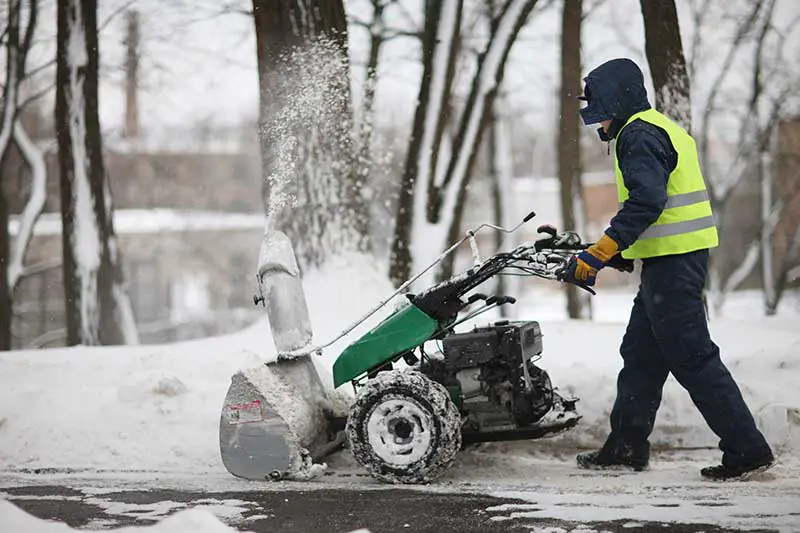Types of Snow Blowers
Single-Stage Snow Blowers
Single-stage snow blowers are lightweight and compact machines ideal for clearing small driveways and sidewalks with snow depths of up to 9 inches. These snow blowers use a single high-speed auger to both scoop up snow and throw it out of the chute. They are best suited for paved surfaces and not recommended for gravel driveways.
Two-Stage Snow Blowers
Two-stage snow blowers are more powerful and can handle snow depths of up to 16 inches. They feature a slower, more powerful auger to break up snow and ice, and an impeller fan to throw the snow out of the chute. These machines are suitable for both paved and gravel surfaces and are typically self-propelled, making them easier to maneuver.
Three-Stage Snow Blowers
Three-stage snow blowers are the most powerful and can handle snow depths of up to 18 inches or more. They feature an accelerator that quickly chops and moves heavy snow and ice through the machine. These snow blowers are best for large driveways, commercial spaces, or areas that experience heavy snowfall.

Factors to Consider When Choosing a Snow Blower
Area to Be Cleared
Consider the size of the area you need to clear. Smaller areas like walkways and short driveways can be easily managed with a single-stage snow blower. For medium-sized driveways and sidewalks, a two-stage snow blower might be more appropriate. Large driveways and commercial spaces would benefit from a three-stage snow blower.
Snowfall Amount and Frequency
Think about the average snowfall in your region and how frequently it snows. If you experience light, infrequent snowfalls, a single-stage snow blower might be sufficient. However, if you live in an area with heavy, frequent snowfall, you may need a two-stage or three-stage snow blower.
Surface Type
Consider the type of surface you’ll be clearing. Single-stage snow blowers are best for paved surfaces, while two-stage and three-stage snow blowers can handle both paved and gravel surfaces.
Budget and Maintenance
Keep your budget in mind when choosing a snow blower. Single-stage snow blowers are typically more affordable, but may not be suitable for heavy snowfall. Two-stage and three-stage snow blowers are more expensive but offer greater power and clearing capabilities. Additionally, consider the maintenance requirements of each type of snow blower. While single-stage snow blowers have fewer parts and are easier to maintain, two-stage and three-stage snow blowers may require more maintenance due to their complexity.
How to Determine the Right Size Snow Blower for Your Needs
Small Driveways and Walkways
For areas up to 1,000 square feet, such as short driveways and walkways, a single-stage snow blower should be sufficient. These machines are compact, easy to maneuver, and can handle snow depths of up to 9 inches.
Medium Driveways and Sidewalks
For areas between 1,000 and 3,000 square feet, including medium-sized driveways and sidewalks, a two-stage snow blower is recommended. These machines can handle snow depths of up to 16 inches and are suitable for both paved and gravel surfaces.
Large Driveways and Commercial Spaces
If you need to clear an area larger than 3,000 square feet, such as large driveways or commercial spaces, consider investing in a three-stage snow blower. These powerful machines can handle snow depths of up to 18 inches or more and are designed for heavy, frequent snowfall.
| Snow Blower Type | Recommended Area Size | Snow Depth Capacity | Surface Compatibility | Price Range |
|---|---|---|---|---|
| Single-Stage | Up to 1,000 sq. ft. | Up to 9 inches | Paved surfaces | $300 – $600 |
| Two-Stage | 1,000 – 3,000 sq. ft. | Up to 16 inches | Paved and gravel surfaces | $600 – $1,500 |
| Three-Stage | Above 3,000 sq. ft. | 18 inches or more | Paved and gravel surfaces | $1,000 – $3,000+ |
Popular Snow Blower Brands and Models
Some popular snow blower brands include Toro, Ariens, Husqvarna, and Cub Cadet. Each brand offers a variety of models to suit different needs and budgets. Be sure to research and compare models before making a decision.
Conclusion
Choosing the right size snow blower depends on the area you need to clear, the type of surface, and the amount and frequency of snowfall in your region. By considering these factors and selecting the appropriate type of snow blower, you can make snow removal more manageable during winter.
Frequently Asked Questions
- Can I use a single-stage snow blower on a gravel driveway? Single-stage snow blowers are not recommended for gravel driveways, as they can pick up and throw gravel, causing damage and potential injury. Two-stage and three-stage snow blowers are better suited for gravel surfaces.
- How do I maintain my snow blower? Regular maintenance includes checking and changing the oil, inspecting belts and cables, and lubricating moving parts. Always consult your owner’s manual for specific maintenance instructions and schedules for your particular snow blower model.
- What is the difference between a two-stage and three-stage snow blower? The main difference is the addition of an accelerator in three-stage snow blowers, which helps to quickly chop and move heavy snow and ice. Three-stage snow blowers are more powerful and can handle deeper snow compared to two-stage models.
- How much should I spend on a snow blower? The cost of a snow blower depends on the type and features you need. Single-stage snow blowers are generally more affordable, ranging from $300 to $600, while two-stage and three-stage models can cost anywhere from $600 to over $3,000.
- Are electric snow blowers as effective as gas-powered models? Electric snow blowers are quieter, more environmentally friendly, and require less maintenance than gas-powered models. However, they may not be as powerful or have the same snow-clearing capacity as gas-powered snow blowers. Electric models are best for smaller areas and lighter snowfall.
